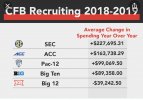- Messages
- 7,425
- Reaction score
- 6,253
Yes. I do believe they think it's important. Despite the purists believing that everything is education, we know darned well that the prowess of the athletic programs creates a draw for enrollment, both for athletics, and beyond. Looking down one's nose at the athletic programs would end up being a costly mistake, because even a large number of the scholastic contributors believe that the athletics are a key element of the school.You think the Presidents and chancellors care about recruiting?
So, recruiting, on it's own, may not take up a moment of time in their discussions, but the fact that a program that doesn't, or can't recruit well because of restrictions, or hindrances due to exposure do play a part in their decision making. Teams that are doormats because of recruiting do not draw donors to the table, like it or not.
Looking back at Wisconsin, the turning point in athletics was Shalala. She gave it a level of importance, but kept it honest, and above board. She may have made some mistakes from her position, but by and large, she helped create the atmosphere that gave the Badgers more stability and potential in athletics.
So, yes. I do believe Presidents and Chancellors care. Their jobs depend on it, because it's part of the fabric of all major universities. If it wasn't, coaches wouldn't be paid millions of dollars a year to put winning teams out there.

